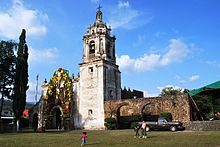- Ocotepec, Cuernavaca, Morelos
-
- This article is about Ocotepec, Morelos. Other similarly named towns exist: Ocotepec, Puebla; Ocotepec, Chiapas.
Ocotepec is a small town to the north of the city of Cuernavaca, but within the municipality of Cuernavaca.[1] The name Ocotepec means “on the hill of the ocotes, or Montezuma pines.” It is located only minutes from the center of Cuernavaca on the highway that leads to Tepotzlán. The community is divided into four neighborhoods based on the major churches in town, which is an organization left over from the colonial period.[2] The four neighborhoods are Candelaria, Dolores, Ramos and Santa Cruz, each with its own patron saint and feast day.[3] This organization is part of the reason why this community has managed to maintain more ancient traditions, a number of which date from the pre-Hispanic period.[2] Ocotepec is one of the most traditional communities in the municipality of Cuernavaca. On the main road through town, there are dozens of stores specializing in handcrafted clay, stone and wood pieces, as well as rustic furniture. Among these shops are restaurants and food stalls specializing in barbacoa and cecina.[3]
Contents
Church of the Divino Salvador
The main church of the town is the Church of the Divino Salvador. This church was begun in 1532 and finished in 1592. It has a single nave, a barrel vault roof, buttresses on the sides, battlements and a bell tower on the south side.[3] The facade of the church is of Baroque style and sculpted out of lime mortar.[1] To the side there are arches of the cloister for the monastery, but this was never finished. The complex faces a large atrium that is surrounded by a wall, which has battlements and a cornerstone with the date of the church’s consecration.[3]
Town cemetery
The other, and perhaps more important, cultural attraction here is the town’s cemetery. It is filled with very traditional examples of tomb construction in modern Mexico. Most of the tombs here are covered over with small-scale churches, cathedrals and houses, which are brightly painted and/or tiled. Here preparations for one of the biggest days of the year are made, Dia de los Muertos.[1].[2]
Dia de los Muertos
Día de los Muertos, or Day of the Dead, is a particularly important event in this town. Most of the traditions here are similar to those in the rest of Mexico with masses, altars to the deceased and visits to the cemetery, but Ocotepec has some unique observances as well. Commemoration of the dead actually begins on the feast day of Saint Luke on October 18th. Much of the time between the 18th and the 31st is taken up with a novena in honor of the deceased.[3] The most notable difference is the “ofrenda nueva” or literally new offering. Altars are especially created to honor those who have died in the past year. These tend to be the most elaborate, decorated with food and drink the deceased enjoyed in life as well as sugar skulls, numerous flowers, such as Mexican marigolds and candles. In the case of children, toys and sweets are laid on the altar. On many altars here, representations of the four elements, earth, water, fire and air are represented by bread, water, candles and crepe paper respectively. There also can be four candles in the form of a cross oriented to the four cardinal directions. This serves to bless the path that deceased is supposed to take as they rejoin he living on this day.[2] The centerpiece of an ofrenda nueva altar is an effigy of the newly-deceased made from fruit, bread and or vegetables, dressed in new clothing and shoes bought for the occasion.[1][2]
Those houses which have a “new offering” that year can be identified by a path of marigold petals that extend from the altar to the sidewalk outside the house. This serves not only as a signal for the recently deceased, as to find his or her way, but it also is an invitation to the living to come into the home and admire the nueva ofrenda altar. Such visitors are greeted with bread, “ponche” (a hot spiced fruit drink), coffee and tamales. In return visitor light candles and/or leave flowers on the altar.[2]
Another tradition that is particular to this town is a procession that happens on the nights of October 31 and November 1. The whole village files into the cemetery on both nights, carrying offerings and food to eat while seated alongside the tombs. Church bells ring on the night of October 31 to announce the arriving Day of Deceased Children, November 1. On this morning, the graveyard is visited and decorated with multicolored flowers and a Mass is said in honor of those children who have passed on. Later that night, church bells ring again to announce Day of the Dead, November 2, when visits are again made and another Mass is said, this time for adults.[2]
References
- ^ a b c d "Ocotepec" (in Spanish). Rutas Turisticas: Morelos (Mexico City: México Desconocido/ Grupo Editorial Impresiones Aéreas) 130: 16. 2006. ISSN 0188-5146.
- ^ a b c d e f g Jamous Galante, Olga. "Día de muertos en Ocotepec, Cuernavaca [Day of the Dead in Ocotepec, Cuernavaca]" (in Spanish). Mexico City: Mexico Desconocido. http://www.mexicodesconocido.com.mx/notas/6126-D%EDa-de-muertos-en-Ocotepec,-Cuernavaca. Retrieved 21 September 2009.
- ^ a b c d e "Ocotepec" (in Spanish). Guia Turistica Morelos. http://www.guiaturisticamorelos.com/ocotepec.htm. Retrieved 21 September 2009.
Categories:- Populated places in Morelos
Wikimedia Foundation. 2010.


